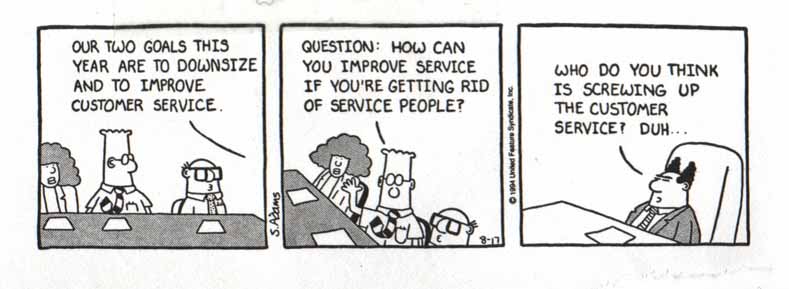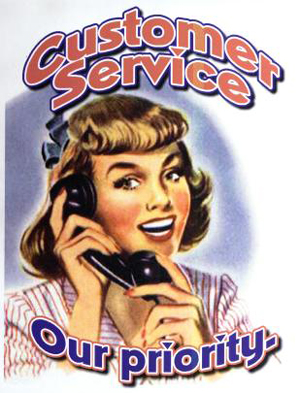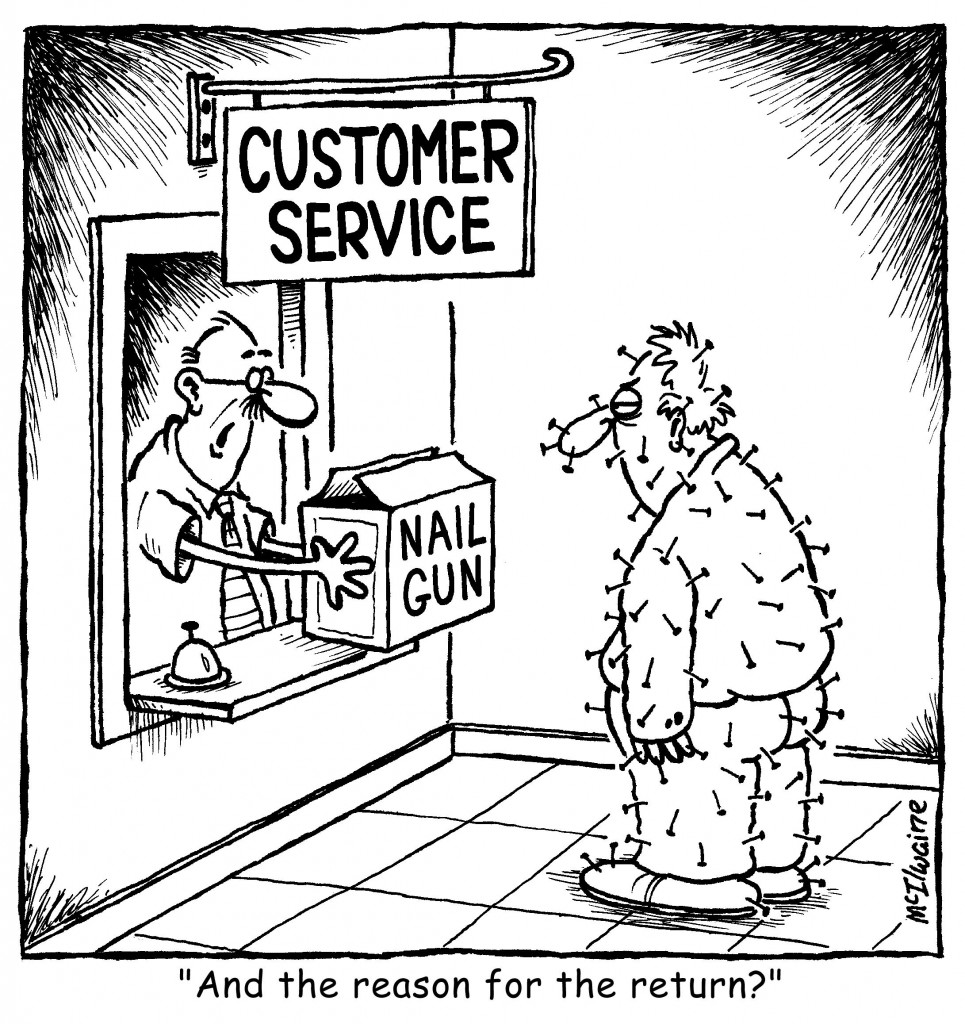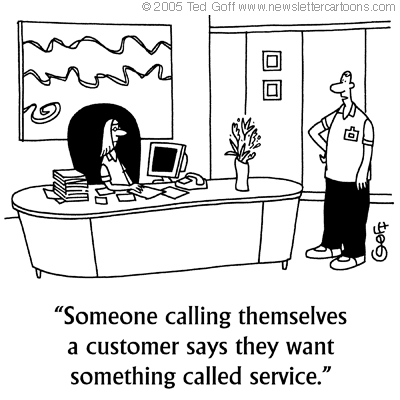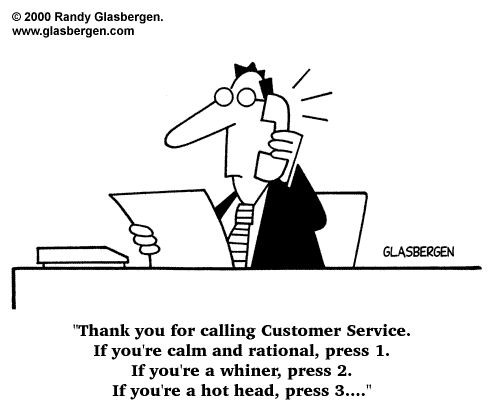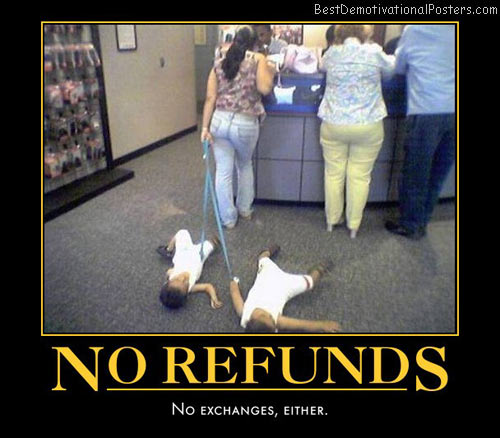In this edition of the Evolution of Technology blog series which is co-written by Professor David E. Weber and myself we take a look at Customer Service. I’ve recently spoken about this on my radio show and I wrote a short Social Media Social Good column that touched on this topic as well. However, Professor David E. Weber and I will now take a look at it through the lenses of the past and present. As this series of columns strives to do, we will remember the way it was and, at least with Professor Weber, those memories tend to be mighty accurate and detailed. I have a hard time remembering what I ate for breakfast. So, forthwith, Professor Weber leads off:
A team of researchers once formally assessed the quality of a particular organization’s customer service unit. So what did those researchers discover? First, that the unit’s “rules and policies were causing a considerable amount of customer dissatisfaction.” Second, they observed “frequent and unwarranted delays in completing investigations of complaints.” Third, they found that most customer “inquiries were referred to the department presumably responsible for the situation that caused the dissatisfaction. This is unsatisfactory because of a department’s tendency to defend its own operations.” All of this made it “almost impossible to give…satisfactory and uniform customer treatment.”
The organization happened to be the municipal agency responsible for managing the water supply for the city of Detroit. No surprise … we all have suffered at the hands of a public utility’s customer service personnel. But get this: That study took place almost 75 years ago — in 1940! So, little has changed in the world of customer service.
I divide the marriage of customer service and technology into three eras. The first era involved no technology, only direct oral communication. I’ll bet that one day, a customer issued an oral punch list to Jesus, the famous Nazarene carpenter. In response, the carpenter probably “defended his operations” and “blamed unwarranted delays on certain rules and procedures” — just as Detroit Water & Power did two millennia later.
Technology and customer service hooked up when humans began using pen, ink and paper to write letters. From a 1741 manual for how to write effective letters comes some suggested content for a letter requesting delinquent payment from a customer: “I find myself constrained by a present exigence, to beg you to balance the account between us….I would not have applied to you, had I known so well how to answer my pressing occasions any other way. If it suits you not to pay the whole, I beg, sir, you will remit me as much towards it as you can….”
A passage in the 1938 book How to Write Good Business Letters contains the following sentence in a sample customer-service letter: “Your letter of July 7 was the first intimation that I had received that your valued business was not being handled to your satisfaction. It is a heavy indictment of our methods, and it disturbs me greatly. I am having a full investigation made, and I shall be prepared to write you fully on the subject within the next two or three days…. (p. 147)”
When was the last time a customer-service representative communicated with you in tones as humble as in those sample letters — especially about a delinquent payment?
The second era — mediated oral communication — began when a critical mass of telephones, and supporting accessories and systems (e.g., direct dialing, 800 numbers, cheaper long-distance rates, telephone calling cards, and more), became routinely available in homes and offices. Did this technological development actually improve customer service? If it did, you wouldn’t know it to hear comedians of the 1950s and ‘60s (such as Nichols and May, Bob and Ray, Bob Newhart) act out goofy but believably unresponsive customer service telephone conversations on stage and television, and in audio recordings.
Mediated oral communication is still with us in customer service. Mobile telephones, calling plans, and numerous toll-free area codes have made it easy for customers to place calls. Voicemail systems, though, have made the actual interface with the organization grueling; as has the practice of outsourcing customer service to offshore call centers.
But other than the organizations themselves, only comedians benefit (They always land on their feet, don’t they?). Audiences readily applaud a story of an outrageous odyssey through voicemail. As for offshore call centers, I shame-facedly plead guilty to laughing at a comic’s riffs — sometimes racist, or at least ethnocentric — on the communication struggles a native speaker of English often experiences when the customer service specialist speaks English only as a second or third language.
The third era — digitally mediated customer service — originated when, in its print, radio or television ads, an organization included web and email addresses for customers to use. It further developed as for more and more organizations; their websites became primary points of access for customers, who could click to a page on which to write an email message.
But did that improve customer service? No. Since the late 1990s when these options emerged, I think I received replies no more than a half-dozen times for dozens of customer-service messages sent. Of those replies, perhaps only two actually took my complaint or inquiry seriously enough to solve my problem. I have received prompts that read, essentially, “Due to the volume of email, we will only respond to a percentage of messages sent to us. Thank you for understanding.” I don’t know why the Webmaster didn’t program an image of a raised middle finger to pop up on the screen. Today, if I must solicit customer service only by email, I don’t even bother trying.
This third era now includes using a variety of social media platforms to contact an organization if you need service. On its customer service web pages, an organization may provide live chat options. It may offer a callback option: a telephone recording announces that the call volume is high and invites me to leave my number and receive a callback. That option I like!
But does any of that sophistication make for better customer service? No. The live chat handles only the most benign service problems, or answers the most innocuous question. The organization’s chat messaging often comes across as macros generated in response to keywords — since when is a ‘bot operating in real time “live”!
Bad development in this era: Endless lists of FAQs, eye-killing to read, impossible to navigate with the inadequate indexing. Worse development: referring customers to video “tutorials” on YouTube. Even worse development: Removing customer service altogether from the organization’s bottom line, and “inviting” customers seeking service rely solely on “our wonderful user community”—and ITS endless FAQs and difficult navigation.
But worst of all: PAYING for customer service! In the ‘90s, my laptop was a Windows machine that used Microsoft application software; and my desktop system was a Mac. Microsoft charged $25 per customer service ticket — no other option, either, because online interactivity for customers scarcely existed. Apple, however, did not charge. Today, though, the “good guys” have gone over to the dark side: My current desktop is an iMac and Apple charges about $35 for assistance unavailable from the alternative servicing strategies I’ve summarized. Just out of principle, though, I refuse to pay for what once I got for free.
When I think of how despair, anger, and powerlessness inhabit the space in which customer service meets technology, I always wonder: Don’t an organization’s elites hate the customer service they seek in their own lives? And if so, why do they inflict it on their own customers? I guess the answer is socioeconomic: Status and income insulate the decision-makers who authorize the thirty-five-dollar calls, the outsourcing and the rest, from having to deal with that sort of thing themselves.
SOURCE NOTES: The study of the Detroit water agency was published in volume 3, issue 9 (Sept. 1940), of Journal of American Water Works Association. The 1741 letter passage, plus historical information about letter-writing books, was pulled from an article by Kitty Locker, published in volume 22, issue 2 (Spring 1985), of Journal of Business Communication. Written by Edward F. Allen, How to Write Good Business Letters (1942) was published by the World Publishing Co. of Cleveland and New York City.
Well Professor, I think our readers will clearly see the reason we work so well as co-writers of this column given your wonderful research and well-crafted breakdown – historically – of customer service. Using the Jesus-as-carpenter analogy was hitting it out-of-the-park. Well done.
I will simply reflect on my own experiences with customer service and how I’ve learned to navigate that sordid world with “fond” memories:
Given that I now have a decent public platform, I’ve resorted to extortion and threats several times when I haven’t gotten satisfactory results. Sadly, it is largely my go-to strategy once I hit any of the roadblocks that Professor Weber outlined above.
Many times these frustrations came from cable/wi-fi/phone “utilities” because I now think of those services as a “utility” since the vast majority of us depend on them just as we depend on water, gas, and heat in our homes.
Almost every time I’ve physically moved my home and/or had to change these sort of “bundle” services, I’ve run into problems that resulted in lots of wasted time “on hold.” My favorite is when they say, “Just a sec” which it never is. I finally hang up and pull out my big “gun.” I tweet, write a column, or speak out on my radio show in “j’accuse” declaration of extreme abuse at the hand of a named company.
In one case, I received a phone call within an hour of my ranting with a miraculous offer to lower my monthly fees and get my problem solved that day. How marvelous.
Other times, I simply dropped the utilities’ “bundle” service that was problematic because those bundles usually mean delegation to outside companies and one hand not knowing what the other is doing. Sadly, this may cost me more money in the long run, but I find it a more satisfactory service.
I remember when the very first all-in-one printer/fax/copy machines came out. Inevitably one of those “bundled” functions would malfunction and I’d lose the use of all three “services!” That taught me to buy three separate machines, in those days. Now, thankfully, most of the all-in-ones work fine. Not so with most of the bundled companies that offer phone, Internet, and television services.
When I switched to Apple computers, after much urging from friends and the final virus shutdown I could take with Windows, I did enter a better world of computer customer service. Apple does do it better (to quote Carly Simon). Most of the time, I buy whatever extended warranties are available from Apple when I buy any of their products. That service has been largely excellent.
But, it’s when I purchase a product that says on its box, “Do not return before calling such-and-such a number or go to such-and-such website” that I know I’m in big trouble. Translated to customer experience – this customer – I know that means I won’t get whatever is in that box to work “right out of the box.” Often, I simply leave the product unopened for weeks trying to muster the courage to confront it all.
This all brings me back to some sweet memories from my childhood, when my parents would pull into a gas station and a uniformed attendant would come out with a big smile and offer to fill the tank and wipe down the windshield I remember going shoe-shopping with my mom as a child, when we’d go to a local shoe store that we regularly frequented and my mom knew the salesman (yes, most were men) by first name and he knew her as “Mrs. Sallan” and we’d get seamless service and inevitably walk out with a new pair of shoes.
Yes, times have changed. All I wish for is for “it” to simply work like a refrigerator which was the title of a column I read long ago by a well-known technology writer who lamented that every new computer he tested required untold hours of tinkering to get it to work. Why can’t they work like toasters and refrigerators?
Is customer service dead? Yeah, I think so, for the most part. Our choice? To navigate it all as best as we can and not to allow “them” to cause our blood pressure to rise. That can be a serious challenge…
How about skipping that $5 Starbucks latte and splurging $2.99 (for the Kindle on Amazon) or $2.79 for the PDF of my new e-book? Enjoy my own informercial for it! This e-book is really a virtual journey. It’s filled with 100 photos, 7 original videos, and links to many of the stops on the trip. Click on the book cover image below to find your purchase options:

